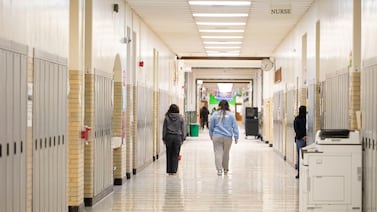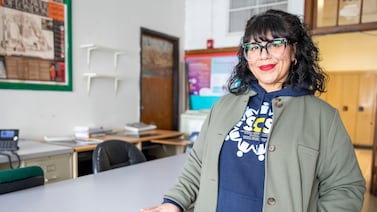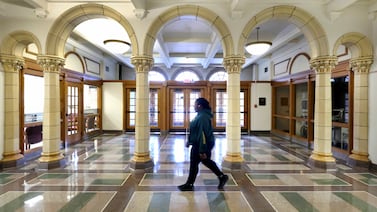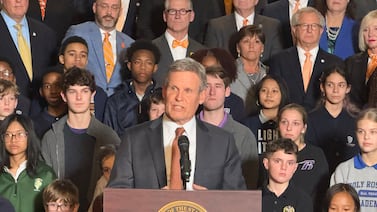Chicago Public Schools will aim to reopen their buildings for in-person learning at least part time this fall.
Pre-kindergarten and some special education students will attend school full-time, most high school juniors and seniors will learn fully online, and all other students will spend two days a week in school buildings, under a tentative plan the district released Friday.
Officials stressed what school ultimately looks like in the fall will hinge on the spread of the coronavirus and the advice of experts, with a final decision coming in late August. They said they will seek input from parents, teachers, and others on what they have called “a preliminary reopening framework” through an online survey and virtual meetings.
The district said it is taking a slew of measures to curb infections in its school buildings: grouping students in pods of roughly 15 students with spaced-out assigned seating, requiring face masks and daily temperature checks, hiring 400 additional custodians to deep clean schools, and more. And Chicago will allow any family to opt out of in-person learning altogether — even if students do not have medical conditions that make them especially vulnerable.
The guidance reflects a strong interest in providing at least some face-to-face instruction in the fall that both school chief Janice Jackson and Mayor Lori Lightfoot have voiced in recent weeks. In pursuing a blended approach, Chicago joins New York City in breaking rank with a slew of large districts nationally — from Los Angeles and San Diego to Houston to Broward County in Florida — that have announced in recent days they intend to continue learning online exclusively, often in response to a spike in COVID-19 cases in those communities.
“We are prepared to take extraordinary steps because the benefits of in-person learning are so profound,” Jackson said at a Friday press event with Lightfoot and other officials.
The district’s teachers union earlier this week called for full-time virtual learning this fall, potentially setting educators on a collision course with district leaders. Union officials argued that the district cannot ensure a safe return to in-person instruction in September.
A recent union poll showed roughly 40% said they do not believe in-person instruction should resume until after a coronavirus vaccine becomes available. On Friday, the union sharply criticized the reopening plan on Twitter, saying it raises a plethora of safety issues, such as students taking public transit to school. The union also charged that the plan fails to address a need for additional educator, nurse, and other staffing as well as various logistical issues, such as art and other elective teachers who work with numerous students in their buildings and can’t be confined to a “pod.”
“The decision by the mayor and CPS to expend time, energy, and money on a plan to reopen school buildings rather than prepare to make full remote learning more rewarding is irresponsible,” the union said in a statement.
Jackson said Friday that the district will offer leaves and accommodations for educators with pre-existing medical conditions, but she said, “The expectation will be that everybody else comes to work.”
In a Thursday report, Raise Your Hand for Illinois Public Education, an influential Chicago-based parent group, stopped short of taking a clear side in the in-person versus remote learning debate. But the group urged “extreme caution” in considering even a part-time return to school buildings.
District leaders said their plan allows the district to quickly shift to all-virtual instruction or full-time in-person learning depending on the course the pandemic takes in the fall.
“I want to make it clear to every parent up front: There will be options for you,” said Lightfoot, who said the coronavirus crisis has strained parents immensely.
She vowed that the city will explore ways to offer childcare and other supports for working families though she offered no details Friday.
Roughly half of district students will be in their school buildings on any given day under Chicago’s plan. The district is gearing up for a so-called “2-1-2 scheduling model,” in which groups of students spend the same two consecutive days each week at school and the same two days learning at home. On Wednesdays, all students will participate in live virtual instruction with their classroom teacher.
The district has bought 1.2 million reusable cloth masks for students and employees, 40,000 containers of disinfectant wipes for each classroom, and 22,000 touchless infrared thermometers. It’s working on a protocol to handle student and employee COVID-19 cases, with officials saying it might be possible to quarantine individual “pods” rather than entire schools.
Officials said the district will prioritize students’ social and emotional well being, and schools will be encouraged to safely welcome juniors and seniors who need extra academic or emotional support or who attend technical education and other programs that are tough to deliver remotely. Students in special education “cluster” programs — small groups of children who receive services separately from classmates — are slated to attend school in person every day.
The district said it is also taking steps to improve remote learning: It’s increasing the time students are expected to spend learning from four to five hours each day, tracking attendance more closely, and embracing the same Google learning platforms across the board.
Allison Arwady, the city’s health commissioner and a licensed pediatrician, voiced strong support for the hybrid plan — even as she acknowledged COVID cases in Chicago are on the rise and stressed she will roll back that support if they increase substantially. But she said a lengthy stretch away from the classroom can do significant damage to children’s physical, emotional, and social health. She pointed to the socialization that takes place in school buildings, the healthy meals they provide and other factors.
“Returning to school is about so much more than academics,” she said, adding that in the experience of other countries that have reopened schools, children adapt quickly to wearing masks and practicing social distancing.
Other urban school districts have also signaled that they are eyeing a hybrid of in-person classes and virtual learning in the fall. New York City announced that its schools would host in-person instruction from one to three days a week, in a bid to drastically lessen the number of students attending on any given day. Parents there also have the option to continue remote learning full time.
But this week saw a steady drumbeat of districts announcing that they plan to stick with full-time remote learning in light of a recent uptick in coronavirus infections in their areas.
State reopening guidelines that Illinois issued in June encouraged districts to provide as much in-person instruction as possible, especially for younger students, those with special needs, and English language learners. But they also gave districts a lot of flexibility to design their own approaches.
Many suburban districts have also started floating their plans for the fall (click here to find Chalkbeat Chicago’s reopening tracker). These districts are embracing a wide range of approaches, though most involve some blend of in-person and remote learning. Some, like Glenbrook, have tentatively suggested they will stick with all-virtual learning.
Others, such as Community Unit School District 300 in Algonquin and Oswego, are gearing up for full-time in-person instruction for elementary and, in some cases, middle school students. Joliet Township High School District 204 will give families a choice between remote learning and a hybrid model.
Chicago officials said their draft framework was informed by a survey of 50,000 parents and 25 focus groups with students, parents, and employees. The public can weigh in on the tentative guidelines through a new survey or at one of five virtual meetings held from July 27 to July 31.
Jackson said Friday that though the district is investing in protective equipment, cleaning supplies and more, she hopes expenses can remain within the $75 million for the district’s COVID response that its governing board has backed. The district will continue to provide transportation for students, with social distancing rules in place.
In Chicago, district officials stressed remote learning will continue to play a role in the foreseeable future, and the district could shift back to full-time online instruction in the event of a spike in coronavirus cases. The city recently announced the $50 million, four-year “Chicago Connected,” a new initiative to provide high-speed broadband internet to as many as 100,000 district students. The goal is to sign up as many of the eligible low-income students as possible before the school year starts this fall.
Chicago recently kicked off all-virtual summer school, which offers a chance to students who received “incompletes” in some of their classes this past spring to make up the work and receive credit. The experience could offer some insights into how to better provide instruction and engage students remotely in the fall.
District leaders have said they are taking a more centralized, streamlined approach, with all students using the same digital learning platforms and sticking to the same schedules. They have not released any enrollment or attendance data yet.
At the press event with Lightfoot, Schaunda Hall, the parent of a student at Willa Cather Elementary in East Garfield Park, said health and safety are top of mind for parents in the neighborhood, which was hit hard by the outbreak. She voiced support for the district’s tentative plan as a strong “starting point,” but she stressed parents must weigh in during the coming weeks to flesh it out.
“The plan to reopen schools should allow for flexibility,” she said. “It should be rooted in equality.”
Zion Trinidad, a senior at Taft High School, said in an interview with Chalkbeat that he is deeply disappointed he would not be heading back to the classroom in September, when he’s taking several challenging college-credit classes and applying to college. He said he yearned for more guidance with school work, especially in honors math, and missed his friends and teachers this past spring.
But he said he understands that keeping upperclassmen home will make the large school safer for freshmen and sophomores.
“To not have that in-person instruction will be really difficult,” he said. “But they are doing it for the safety of the students. It would be difficult to focus on the academics if you are wondering if someone might be sick.”
Valerie Carroll, a parent of four students in the district, said the coming fall puts families like hers in a tough spot. She said her children struggled with a lack of support, technology issues, limited communication from their schools, and more during the remote learning stretch. Carroll was stunned to see one daughter, an eighth-grade honor roll student, receive an incomplete in math.
But she also said she worries whether the district will maintain clean schools and take sufficient measures to keep students safe.
“Remote learning has not been good on my babies at all,” she said. “At the same time, I want my kids to live.”
Tracy Occomy Crowder, a deputy director at Community Organizing and Family Issues, which advocates for parents of color statewide, said the perspectives of the group’s parent leaders capture the divisions among families on school reopening: 30% want a return to classrooms largely because of childcare challenges, 30% feel strongly schools should remain closed, and the rest are on the fence or support a blended approach. A key question is whether the city and district are working on ways to support childcare for families, particularly those who don’t have the choice of working from home.
“Our ideal scenario gives parents and teachers options,” she said. “The release of their plan is just the beginning of this conversation.”
Reporting contributed by Yana Kunichoff.






